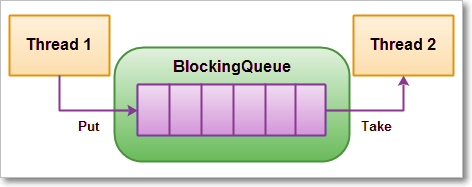Concurrent Collections

List – CopyOnWriteArrayList
-
CopyOnWriteArrayList is a thread-safe variant of java.util.ArrayList.All mutative operations (add, set, and so on) are implemented by making a fresh copy of the underlying array.
-
As the name indicates, CopyOnWriteArrayList creates a Cloned copy of underlying ArrayList, for every update operation at certain point both will synchronized automatically which is takes care by JVM. So, there is no effect for threads which are performing read operation.
-
It is costly to use because for every update operation a cloned copy will be created. Hence CopyOnWriteArrayList is the best choice if our frequent operation is read operation.
-
The underlined data structure is grow-able array &
-
It is thread-safe version of ArrayList.
Methods Summary:
public boolean addIfAbsent(Object obj)
public int addAllAbsent(Collection C)
Differences between ArrayList & CopyOnWriteArrayList
1.Synchronization
ArrayList is not synchronized . CopyOnWriteArrayList
is synchronized .
2.Iterator
-
Iterator of CopyOnWriteArrayList is fail-safe & doesn’t throw ConcurrentModificationException even if underlying CopyOnWriteArrayList is modified once Iteration begins
-
Because, Iterator is operating on a separate copy of ArrayList. Consequently, all the updates made on CopyOnWriteArrayList is not available to Iterator
3.Remove Operation
Iterator of CopyOnWriteArrayList doesn’t support remove operation while Iterator
of ArrayList supports remove() operation.
4.Performance
ArrayList is faster as it is not synchronized. That means
many threads can execute the same piece of code simultaneously. In comparison ,
CopyOnWriteArrayList is slower.
5.Added in java version
ArrayList class was added in java version 1.2 ,
while CopyOnWriteArrayList class was added in java version 1.5 (or java 5) .
6.Package
ArrayList class is present in java.util package , while
CopyOnWriteArrayList class is present in java.util.concurrent package
public class CopyOnWriteArrayListExample {
public static void main(String args[]) {
CopyOnWriteArrayList<String> list = new CopyOnWriteArrayList<String>();
list.add("Java");
list.add("J2EE");
list.add("Collection");
//add, remove operator is not supported by CopyOnWriteArrayList iterator
Iterator<String> itr = list.iterator();
while(itr.hasNext()){
System.*out*.printf("Read from CopyOnWriteArrayList : %s %n", itr.next());
// itr.remove(); //not supported in CopyOnWriteArrayList in Java
list.add("New");
}
System.*out*.println(list);
}
}
Set – CopyOnWriteArraySet, ConcurrentSkipListSet
CopyOnWriteArraySet
-
CopyOnWriteArraySet is a Set that uses an internal CopyOnWriteArrayList for all of its operations.
-
One of the most important thing to know about CopyOnWriteArraySet is that it is backed by CopyOnWriteArrayList, which means it also share all basic properties of CopyOnWriteArrayList.
-
Another important thing to remember is that Iterators of this collection class doesn’t support remove() operation, trying to remove an element while iterating will result in UnSupportedOperationException.
-
it’s a little brother of CopyOnWriteArrayList, so if you understand one of them, you can use others. Only difference being these two are one is List and other is Set, but that brings all difference between Set and List in Java. For example, List is ordered, allows duplicate while Set is unordered, but doesn’t allow duplicate.
ConcurrentSkipListSet
-
ConcurrentSkipListSet maintains the behavior same as TreeSet.
-
Since ConcurrentSkipListSet implements NavigableSet in Java, it is a sorted set just like TreeSet with added feature of being concurrent. Which essentially means it is a sorted data structure which can be used by multiple threads where as TreeSet is not thread safe.
-
The elements of the ConcurrentSkipListSet are kept sorted according to their natural ordering, or by a Comparator provided at set creation time, depending on which constructor is used.
-
ConcurrentSkipListSet provides a constructor that takes a comparator as a parameter.
-
ConcurrentSkipListSet(Comparator<? super E> comparator) - Constructs a new, empty set that orders its elements according to the specified comparator.
-
ConcurrentSkipListSet implementation provides expected average log(n) time cost for the contains, add, and remove operations and their variants. Insertion, removal, and access operations safely execute concurrently by multiple threads.
Map – ConcurrentMap ConcurrentHashMap, ConcurrentSkipListMap
ConcurrentMap:
ConcurrentMap is an interface, which is introduced in JDK 1.5 represents a Map which is capable of handling concurrent access
It extends map interface in Java. Below are specific methods of ConcurrentMap interface:
-
Object putIfAbsent(K key, V value):If the specified key is not already associated with a value, associate it with the given value.
-
boolean remove(Object key, Object value) Removes the entry for a key only if currently mapped to a given value.
-
boolean replace(K key, V oldValue, V newValue) Replaces the entry for a key only if currently mapped to a given value
ConcurrentHashMap
-
ConcurrentHashMap only locks a portion of the collection on update.
-
ConcurrentHashMap is better than Hashtable and synchronized Map.
-
ConcurrentHashMap is failsafe does not throws ConcurrentModificationException.
-
null is not allowed as a key or value in ConcurrentHashMap.
-
Level of concurrency can be chosen by the programmer on a ConcurrentHashMap while initializing it.
ConcurrentHashMap(int initialCapacity, float loadFactor, int concurrencyLevel)
By default ConcurrentHashMap allows 16 number of concurrent threads. We can change this number using the concurrencyLevl argument.
ConcurrentSkipListMap
Since ConcurrentSkipListMap implements ConcurrentNavigableMap, it is a sorted map just likeTreeMap (Which also implements NavigableMap interface).
ConcurrentSkipListMap is sorted according to the natural ordering of its keys, or by a Comparatorprovided at map creation time, depending on which constructor is used.
ConcurrentSkipListMap in Java provides four constructors, out of those 2 relevant ones are -
-
ConcurrentSkipListMap() - Constructs a new, empty map, sorted according to the natural ordering of the keys.
-
ConcurrentSkipListMap(Comparator<? super K> comparator) - Constructs a new, empty map, sorted according to the specified comparator.
ConcurrentSkipListMap class in Java implements a concurrent variant of SkipLists data structure providing expected average log(n) time cost for the containsKey, get, put and remove operations and their variants. Insertion, removal, update, and access operations safely execute concurrently by multiple threads.
All Map.Entry pairs returned by methods in ConcurrentSkipListMap class and its views represent snapshots of mappings at the time they were produced.
Queue – BlockingQueue PriorityBlockingQueue ,ArrayBlockingQueue,
BlockingQueue
A BlockingQueue is typically used when one thread will produce objects, another thread consumes those Objects.

A BlockingQueue with one thread putting into it, and another thread taking from it.
| Throws Exception | Special Value | Blocks | Times Out | |
|---|---|---|---|---|
| Insert | add(o) | offer(o) | put(o) | offer(o, timeout, timeunit) |
| Remove | remove(o) | poll() | take() | poll(timeout, timeunit) |
| Examine | element() | peek() |
- BlockingQueue in Java doesn’t allow null elements, various implementations like ArrayBlockingQueue, LinkedBlockingQueue throws NullPointerException when you try to add null on queue
two types of BlockingQueue:
1.Bounded queue – with maximal capacity defined
BlockingQueue<String> blockingQueue = new LinkedBlockingDeque<>(10);
2.UnBounded queue –no maximum capacity, can grow almost indefinitely
BlockingQueue<String> blockingQueue = new LinkedBlockingDeque<>();
Producer-Consumer Example
BlockingQueue provides a put() method to store the element and take() method to retrieve the element. Both are blocking method, which means put() will block if the queue has reached its capacity and there is no place to add a new element.
Similarly take() method will block if blocking queue is empty. So, you can
see that critical requirement of the producer-consumer pattern is met right
there, you don’t need to put any thread synchronization code.
class Producer extends Thread {
private BlockingQueue<Integer> sharedQueue;
public Producer(BlockingQueue<Integer> aQueue) {
super("PRODUCER");
this.sharedQueue = aQueue;
}
public void run() { // no synchronization needed
for (int i = 0; i < 10; i++) {
try {
System.out.println(getName() + " produced " + i);
sharedQueue.put(i);
Thread.sleep(200);
// if we remove sleep, put will execute 10 times, then take will execute
} catch (InterruptedException e) {
e.printStackTrace();
}
}
}
}
class Consumer extends Thread {
private BlockingQueue<Integer> sharedQueue;
public Consumer(BlockingQueue<Integer> aQueue) {
super("CONSUMER");
this.sharedQueue = aQueue;
}
public void run() {
try {
while (true) {
Integer item = sharedQueue.take();
System.out.println(getName() + " consumed " + item);
}
} catch (InterruptedException e) {
e.printStackTrace();
}
}
}
public class BlockingQueueDemo {
public static void main(String[] args) {
BlockingQueue<Integer> sharedQ = new LinkedBlockingQueue<Integer>();
Producer p = new Producer(sharedQ);
Consumer c = new Consumer(sharedQ);
p.start();
c.start();
}
}
-
ArrayBlockingQueue – a blocking queue class based on bounded Java Array. Once instantiated, cannot be resized.
-
PriorityBlockingQueue – a priority queue based blocking queue. It is an unbounded concurrent collection.
-
LinkedBlockingQueue – an optionally bounded Java concurrent collection. Orders elements based on FIFO order.
Deque - ConcurrentLinkedDeque
ConcurrentLinkedDeque in Java is an unbounded thread-safe Deque which stores its elements as linked nodes. Since it implements deque interface ConcurrentLinkedDeque supports element insertion and removal at both ends. You will find methods like addFirst(), addLast(), getFirst(), getLast(), removeFirst(), removeLast() to facilitate operations at both ends.
Usage of ConcurrentLinkedDeque
A ConcurrentLinkedDeque is an appropriate choice when many threads will share
access to a common collection as concurrent insertion, removal, and access
operations execute safely across multiple threads.
Note that it doesn’t block operations as done in the implementation of BlockingDequeue interfacelike LinkedBlockingDeque. So there are no putFirst(), takeFirst() or putLast(), takeLast() methods which will wait if required.